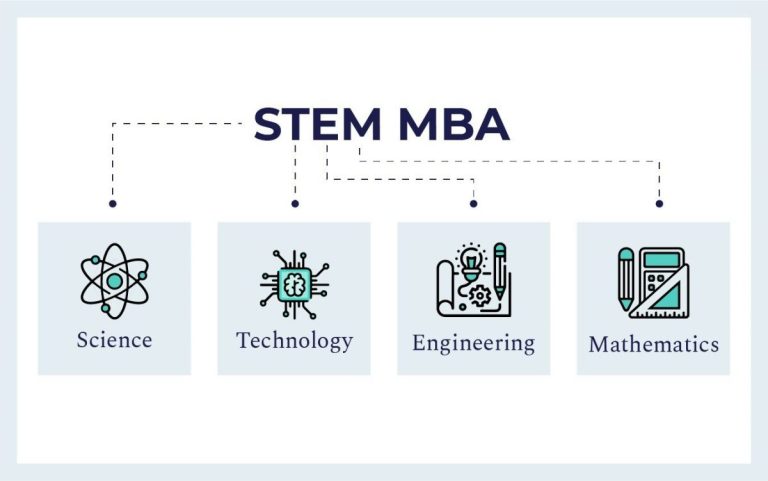While not a new concept, STEM MBA programs in USA have witnessed a significant rise in popularity in recent years among both US and international applicants.
If you’re considering joining the bandwagon of MBA STEM courses in USA, it’s crucial to know them in detail first.
What is a STEM MBA?
STEM is an abbreviation for Science, Technology, Engineering, and Mathematics. Therefore, STEM MBA programs are the ones that focus on STEM subjects while imparting management and leadership skills to students.
What Are the Eligibility Criteria for a STEM MBA in USA?
The basic eligibility criteria for a US MBA program are similar across different business schools. These include having an undergraduate degree, a few years of work experience, a strong GMAT score, etc. But, there are no special criteria for pursuing an MBA STEM courses in USA.
Top STEM MBA programs in USA
Today, many prominent US B-schools offer MBA programs with STEM tracks. Many more are expected to follow suit in the coming years due to the rising popularity and demand for these programs among international MBA applicants as well as the big corporate firms.
Following is the list of top US B-schools that offer quality STEM MBA courses through STEM tracks and elective courses.
| Sr. No. | Business School | STEM Designation | Program Duration | Estimated Tuition fees ($) |
| 1 | The University of Chicago Booth School of Business | Full-time MBA | 24 | 1,40,000 |
| 2 | Columbia Business School | MBA | 16-20 | 1,54,752 |
| 3 | Harvard Business School | MBA with STEM specialization | 24 | 1,46,880 |
| 4 | University of Michigan’s Ross School of Business | MBA | 24 | 1,44.228 |
| 5 | MIT Sloan School of Management | MBA | 24 | 1,57,908 |
| 6 | Stanford University’s Graduate School of Business | MBA | 24 | 1,49, 412 |
| 7 | New York University’s Leonard N. Stern School of Business | Full-time MBA | 24 | 1,57, 400 |
| 8 | Cornell University’s Samuel Curtis Johnson Graduate School of Management | Tech MBA | 12 | 1,14, 632 |
| 9 | University of California’s Walter A. Hass School of Business | MBA | 24 | 1,43, 634 |
| 10 | Northwestern University’s Kellogg School of Management | Majors and pathways (STEM) in the MBA program | 24 | 1,52, 736 |
Disclaimer: The tuition fees are just an estimate to let the prospective students have an idea of the fees. Please refer to the official sources for the current course fees.
Why Should You Choose a STEM MBA?
Best of Both Worlds
You learn business fundamentals and technical knowledge in your chosen STEM subject. For instance, elective courses on data science, data analytics, or digital innovation can add more value to your MBA degree.
Demand for Expertise
Companies are increasingly using the latest technologies like artificial intelligence, digital integration, etc., in their traditional business operations like logistics, supply chain, etc. Naturally, such businesses would be looking for managers with the relevant knowledge or expertise to identify opportunities and potential challenges while integrating technology with businesses.
Better Salary
Digital integration and continuous technology penetration in traditional jobs are increasingly blurring the line between humans and machines. However, this revolution is also expected to create new job roles and responsibilities. As a result, the demand for STEM MBA grads can continue going northwards in the upcoming years resulting in greater potential for career growth with better remuneration packages.
The World Economic Forum has estimated the emergence of 97 million new roles by 2025, most of them would be related to STEM.
Additional Visa Extension
The US visa rules allow international students to work in the USA under optional practical training or OPT after they graduate from US universities and colleges. The feature helps students concentrate on their studies during the commencement of the degree program.
OPT extension is allowed for an initial period of 12 months from the date of graduation. However, STEM students, including MBA grads with STEM tracks, can get an additional extension of 24 months to stay in the USA for work. So, students passing one of the STEM MBA programs in USA can get a total OPT extension of 36 months on their visa.
Remember, the STEM MBA program should be done at SEVIS-approved and accredited US universities.
Networking Opportunities
Having an outstanding technical background can help students get more networking opportunities during their MBA program. You can connect with college alumni who’re already established in the STEM MBA field and ask for their advice.
Additionally, you can have higher opportunities to study alongside like-minded students who might have excellent technical leverage and STEM-relevant work experience.
From electives and dual degree courses to fully integrated STEM MBAs, individuals interested in pursuing STEM MBA courses in USA have many options. With businesses becoming more tech-savvy than ever, competent STEM MBA graduates can prove to be an asset, and businesses know it well. Are you ready to become a part of the new STEM revolution?
FAQs related to Stem MBA Programs in USA
1. Who should pursue STEM MBA programs USA?
STEM MBA in USA are best suited for MBA applicants with science and technology backgrounds compared to applicants from non-technical backgrounds.
2. What are the career prospects of a STEM MBA in USA?
You can choose to pursue a career in business analytics, data science, or any other technology with a STEM MBA in USA depending on the electives or majors you choose with your MBA.
3. Is a STEM MBA different from a regular MBA?
Not in a strict sense. Some B-schools offer separate Tech MBA degrees apart from a regular MBA, but that’s not always the case. Many reputed business schools either offer STEM subjects as majors with a regular MBA degree or a dual degree comprising an MS and MBA degree.





